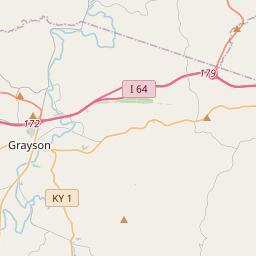Iron Hill Furnace







Later Charlotte, built in 1873 by Iron Hills Furnace and Mining Co. It has an iron shell stack 49 ft. high, with a maximum diameter inside of 121/2 ft. Largest blast furnace intended to use charcoal fuel in the Hanging Rock Iron Region, it produced only 962 tons of iron for first owners. Ceased operating before 1884. Marker presented by Armco Steel Corp.(Reverse) Iron Made in Kentucky - A major producer since 1791, Ky. ranked 3rd in US in 1830s, 11th in 1965. Charcoal timber, native ore, limestone supplied material for numerous furnaces making pig iron, utensils, munitions in the Hanging Rock, Red River, Between Rivers, Rolling Fork, Green River Regions. Old charcoal furnace era ended by depletion of ore and timber and the growth of railroads
The famous Hatfield-McCoy feud, a long-running and violent conflict between two Appalachian families, began in Kentucky in the late 19th century.
In the early years, Carter County was primarily agricultural, with farming and livestock production being the main occupations of its residents. The county's fertile soil and diverse landscape made it suitable for a wide range of crops, including tobacco, corn, and wheat. The development of transportation infrastructure, such as roads and railroads, further facilitated the growth of agriculture in the region.
During the Civil War, Carter County, like many other parts of Kentucky, experienced a great deal of unrest and conflict. While the county officially remained loyal to the Union, it was still heavily divided, with many residents joining both Union and Confederate forces. The Battle of Carter's Crossroads, fought in 1862, was a notable event during this time.
In the late 19th and early 20th centuries, Carter County saw the rise of coal mining as a major industry. The county's vast coal reserves attracted numerous mining companies, leading to an economic boom and population growth. However, the decline of the coal industry in the latter half of the 20th century resulted in the closure of many mines and a subsequent population decline.
Today, Carter County is a blend of its rich history and modern developments. Though it has faced economic challenges, the county continues to strive for growth and sustainability. The preservation of its historical sites and the promotion of tourism are key initiatives that highlight Carter County's unique heritage and contribute to its local economy.
Carter County Timeline
This timeline provides a concise overview of the key events in the history of Carter County, Kentucky.
- 1800: Carter County was established on February 9th as part of the Virginia state.
- 1822: The first settlement, known as Wilson's Station, was established by Samuel and William Wilson.
- 1838: The county seat was moved from Wilson's Station to Grayson.
- 1870s: The Chesapeake & Ohio Railway was built, providing transportation and economic growth to the county.
- 1930s: The Great Depression hit Carter County, causing economic hardship for its residents.
- 1954: A devastating flood occurred in Carter County, causing significant damage to homes and infrastructure.
- 1997: The EastPark industrial complex was established, attracting businesses and creating job opportunities.
- 2020: Carter County celebrates its 220th anniversary since its establishment.